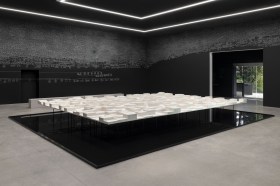One of the best places to gauge the directions in which contemporary art is headed is Barcelona’s CCCB (Centro de Cultura Contemporanea de Barcelona). Often the most interesting programmes are outside the main exhibitions, the current jumble that is Visionary Catalonia being a case in point. Thankfully, the museum also hosts a million side-bars, showcasing work in all media from film to sound via installations, photography and art.
One of February’s highlights was The Influencers, a three-day festival bringing together practitioners who are shaping the current artistic environment. World-class guests included the graffiti artist Blu, who appeared in Einstein moustache, glasses and wig for ‘security reasons’” Improv Everywhere, the group behind flash-mobbing such as the moment when half of Grand Central Station suddenly and inexplicably stood still” and Swoon an artist who builds rafts and, along with a bunch of musicians, sails them down the Hudson, taking music to unsuspecting locals at various points along the way.
Despite the use of such disparate media, these artists all had one striking common denominator: the old-school nature of their chosen materials. All of the projects were playfully provocative, conceptually simple and, in their execution, seemed to hark back to a time when schoolboy pranks were enjoyed by old ladies who sat outside to catch the sunshine. Surprisingly, none of them were high-tech. Materials used included junk, spray paint, the human body, and even clockwork mega-toys. It was surprising to discover that e-generation artists are eschewing ‘digital culture,’ in favour of the tools of their childhood.
Even the contemporary galleries are at it. Rojo, which also has spaces in cities across the world, works with a surprising number of designers and painters whose style can only be described as naïve.
It’s not just that Barcelona’s avant-garde doesn’t want to grow up. Nostalgia is a creeping phenomenon. Fairy-tale illustration has begun to infiltrate advertising (much of it shot here) that once prided itself as shiny” gigs are overwhelmingly indie or given by global sextagenarians” and a considerable proportion of the Spanish films produced last year re-visited their Civil War.
It’s understandable that, at a time when it feels as though the foundations of the society we’ve built for ourselves are collapsing, looking back to when bank managers at least seemed like honest brokers is an attractive form of escapism. But this kind of escapist nostalgia is the least artistically successful. This is perhaps best illustrated in film, where you really are transported to a lost world.
In Stephen Frears’ latest, Chéri, the heroine is allowed to have the money that affords her a truly exquisite luxury, as she fucks (over) rich men for her living. But a problem lies beneath all the gorgeous trimmings (Michelle Pfeiffer included) and that is that the tale, based on two short stories by Colette, simply doesn’t ring true. These days, young fops aren’t forced to marry young heiresses simply so that their mother can have grandchildren. And this lack of a ‘universal truth,’ leaves the film feeling hollow.
Where contemporary nostalgia works is where it’s saying, reflecting or playing on something modern. To return to the CCCB, flash-mobbing uses the very modern technology of mass communications” mobile phones or portable mp3 players enable the provision of hidden but simultaneous instructions to large groups of people in an urban setting. The group behind the mobs then also films the happenings and uploads them onto You Tube, for the entertainment of viewers world-wide.
But it’s not just the medium that’s modern. Improv Everywhere play on the anonymity and routine of city living. Their most regular event occurs annually on the New York Subway. A person enters a subway car having ‘failed’ to put their trousers on. Fellow commuters are usually highly entertained, but in the way of all commuters, keep their thoughts to themselves. Then at the next metro stop, another trouserless man enters the carriage. This continues until there are more people without trousers than without in this particular capsule, by which time most people cotton on to the ‘joke,’ and start to actually converse with their fellow ‘passengers’.
Equally, the ‘war,’ between giant mechanical robots organised by Survival Research Laboratories is particularly telling in today’s context. Traditional warfare is now won by the size and skill of your technological firepower rather than your human cavalry. Watching targets explode in Iraq during the invasion was akin to watching a video game. So the distance and even the admiration for the maker’s skill felt when watching the robot spectacle has a modern edge.
Perhaps, like all time-based sentiment, nostalgia works best with its nose in today’s dirt. The contrast between past and present that’s brought to the surface by the use of analogue techniques in a digital world creates a warped mirror, reflecting contemporary realities with acerbic precision.





